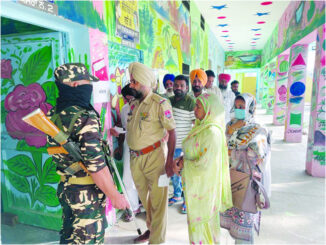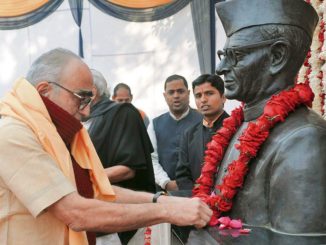
Being one of the most widely worshipped Gods in Hinduism, Lord Shiva is also referred as Tryambaka Deva (Three-eyed lord) for the third eye placed on his forehead. The sun is said to be his right eye, the moon is said to be the left eye while fire is this third eye. While the other two eyes indicate his activity in the physical world, the third eye stands as a symbol of wisdom, free from “Maya” (illusion) and duality of life. It looks beyond the obvious happenings with clear perception, and shows one what is known to be true. This eye of Lord Shiva is known as the “Spiritual eye” which stands for deeper consciousness and allows us to see the real world for the world as we see it is an illusion.
As per the modern spirituality, the third eye is a symbol of enlightenment. It is often referred to as “Gyananakashu” (the eye of knowledge). In the Indian and East Asian iconography, the third eye is the “Ajna chakra” (the sixth chakra). It is also known as brow chakra or brow center.
This third eye of Lord Shiva is also famous for emitting flames that destroy the vie and the evil. It is believed that Lord Shiva has only opened the third eye in extreme cases, when there no more space for forgiveness was left and no question of granting another chance existed. It was his third eye, which gave him the name of the destroyer; when the eye opened it destroyed the person who befell for the vision.
History saw instances where Lord Shiva opened his third eye, yet there are no evidences on how many times, this event took place. The Shiv Purana lays down a few instances when Mahadeva opened his third eye. We have jotted down a few of such popularly known instances.
Sati and the Burning of Kamadeva
Daksha Prajapati, Lord Brahma’s wish-born son, was entrusted with the duty to populate the Universe. He with his wife, Prastuti, had many daughters who were married off to gods and sages. Sati, his youngest daughter, was his favourite. Sati was the reincarnation of Ardhashakti, or the better half of Lord Shiva which he had sacrificed to maintain the balance in the Universe and was thus, destined to marry Lord Shiva. Sati then appeases Lord Shiva and marries him against the wishes of her father, Daksha. He then organizes a yagna (fire-sacrifice) and invites all his sons-in-law except Shiva, to participate in the ritual. Angry at the exclusion of her husband, Sati rushes into the sacrificial precinct and confronts her father, who mocks Shiva’s ascetic ways in front of all the assembled guests. Unable to bear this humiliation in front of the other Devas, Sati kills herself by jumping into the sacrificial fire thereby causing the Yagna to stop.
Lord Shiva was furious after learning about Sati’s death at the Yagna. Unable to control his anger, he brought forth superior beings Virabhadra (a fierce warrior) and Bhadrakali (the female fierce warrior) to behead Daksha. Although many gods tried to defend Daksha, Virabhadra and Bhadrakali destroyed his army and beheaded him.
Lord Brahma pleaded to Lord Shiva for his son’s life and asked for forgiveness for his behaviour. Lord Shiva calmed down, and revived Daksha by replacing his head with a goat’s head. He placed Goddess Sati’s body on his shoulder and started walking through the Universe, neglecting his duties. Lord Vishnu attempted to pacify Shiva, who was left in deep grief upon seeing the half-burned corpse of his beloved wife, Sati. To bring Lord Shiva out of his grief, Lord Vishnu uses his sudarshan chakra (a celestial weapon) to cut Sati’s body to pieces, which fell on earth. Sati’s body was cut into a total of 52 pieces that fell on different places on the earth, each of which have evolved into Shakti Pithas (Shakti Temples). There is a Kali or Shakti temple in each of these 52 places.
Lord Shiva then returned to Mount Kailash to meditate and mourn his wife’s death, cleansing himself of all anger and pain rejecting all worldly things. Much later, Sati is reborn as the daughter of Himavath (the king of mountains). The couple name her Parvati and showed immense devotion towards Lord Shiva. She tries her best to please him to marry her. Although Lord Shiva remains impassive, disappointing both her and the Devas who are eager to get Lord Shiva married. The Devas were informed that the demon, Taraka, who got them in trouble was destined to be killed by Lord Shiva and Goddess Parvati’s son. So, they decide to help Parvati please Lord Shiva by sending Lord Kama (the god of love & lust) to Mount Kailash. While Lord Shiva is seen meditating, Kamadeva raises his sugarcane bow, pulls his bowstring buzzing with bees and shoots flowery darts of kama (desire) into Shiva’s heart.
The result was not something the Devas expected it would be. Instead of opening his eyes and expressing his desire for Parvati, Lord Shiva opens a third eye. It is in the centre of the forehead and blows out a missile of fire that sets Kamadeva aflame. Right infront of Parvati, Kamadeva is reduced to a pile of ashes in no time. It is then that Shiva gets the name destroyer. Such is the power of the third eye of Lord Shiva. Through this incident, the third eye has been accompanied by emotions of rage and anger.
The birth of Andhaka
As the Shiv Purana narrates, once playfully Parvati closes the eyes of Lord Shiva with her hands from behind. As soon as Mahadeva’s eyes were thus covered, all the regions became dark and life seemed to be extinct everywhere in the universe. All living creatures became cheerless and filled with fear. Birds froze in the air mid-flight. Cows became living statues while grazing in their lush green fields. The tiger about to pounce on her prey was rooted to her hiding spot while the deer was fastened to his feeding ground. All life became still and quiet. When the eyes of the lord of all life forms were closed, the universe seemed to become sunless. Soon, overspreading darkness disappeared. A mighty and powerful flame of fire started to radiate from Mahadeva’s forehead. A third eye, resembling another sun, appeared on his forehead. This eye provided light to the world when his other two eyes were closed.
While covering Lord Shiva’s eyes, Goddess Parvati’s hands started perspiring. The sweat filled with the power of Shiva (heat) and Shakti (water) transformed into a child – a blind child. It sang, cried, laughed, danced, put out its tongue like a serpent and thundered fiercely. The couple named this child – Andhaka. At this time, there was an asura (demon) named Hiranyaksha who had no sons. He then prayed to Lord Shiva and pleased by his devotion, the couple decided to offer him with Andhaka, to raise him as his son.
Andhaka went on to become the kind of Hiranyaksha’s kingdom. Later, Andhaka gets blessed with a boon from Lord Brahma. Andhakasura asked him for victories throughout his life and immortality. Lord Brahma granted him the first boon but asked him how he wanted die, as death was inevitable. To this, Andhakasura replies that he would be killed by his own father if he ever decides to marry a woman who was like a mother to him. Empowered by this boon, he went on to conquer all the three worlds. During his invasion, he meets Parvati and gets aroused by her beauty. He then decided to make her his queen. As he chased her, Lord Shiva who came to Parvati’s rescue and struck Andhaka by his trident. After being suspended on Lord Shiva’s trident for over thousand years, Andhakasura realised his mistake and sought forgiveness form Lord Shiva. This story narrates the dark side of the third eye. When desire is destroyed, then all divisions fall apart – there is no right side or left side, nothing good or nothing bad. It metaphorically illustrates that the physical world, blinds one to worldly realities. Andhaka means the `blind one’, so blind that he does not even distinguish between mother and wife.
Source: Templepurohit.com





Be the first to comment